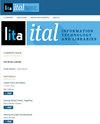忠于自己的 3D 自拍
IF 1.3
4区 管理学
Q3 COMPUTER SCIENCE, INFORMATION SYSTEMS
引用次数: 0
摘要
为了推广学术图书馆创客空间,密西西比大学图书馆主办了一个使用人体扫描技术的 "3D 自拍 "展台。该展台在开课的前几周就在校园内做了广告,并设立在图书馆外,旨在通过使用人体扫描技术吸引人们的注意,并在日后在创客空间打印出来。虽然希望打印 "自拍照 "的愿望没有实现,但该项目获得了有关感兴趣的读者的数据以及今后开展类似项目的想法。本文可作为案例研究,供有兴趣开展类似推广活动的其他学术图书馆创客空间参考。本文章由计算机程序翻译,如有差异,请以英文原文为准。
To Thine Own 3D Selfie Be True
To promote an academic library makerspace, the University of Mississippi Libraries hosted a “3D selfie” booth which used body scanning technology. This booth, advertised on campus and set up outside the library during the first weeks of class, was designed to attract attention and perform outreach through the use of body scans to be printed in the makerspace at a later date. Although the hoped-for printing of “selfies” did not materialize, the project resulted in data about interested patrons and ideas for similar projects going forward. This paper serves as a case study for other academic library makerspaces interested in similar outreach.
求助全文
通过发布文献求助,成功后即可免费获取论文全文。
去求助
来源期刊

Information Technology and Libraries
管理科学-计算机:信息系统
CiteScore
2.90
自引率
5.60%
发文量
25
审稿时长
1 months
期刊介绍:
Information Technology and Libraries publishes original material related to all aspects of information technology in all types of libraries. Topic areas include, but are not limited to, library automation, digital libraries, metadata, identity management, distributed systems and networks, computer security, intellectual property rights, technical standards, geographic information systems, desktop applications, information discovery tools, web-scale library services, cloud computing, digital preservation, data curation, virtualization, search-engine optimization, emerging technologies, social networking, open data, the semantic web, mobile services and applications, usability, universal access to technology, library consortia, vendor relations, and digital humanities.
 求助内容:
求助内容: 应助结果提醒方式:
应助结果提醒方式:


